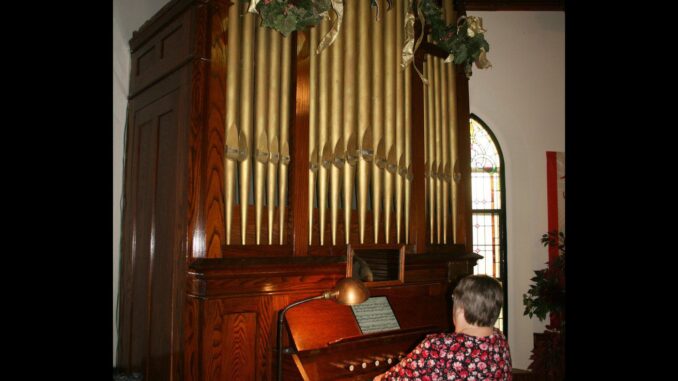
By Bird Bouchard, Local Journalism Initiative Reporter, The Ridgetown Independent News
A historic local pipe organ will soon have a new home.
Built in the 1890s, the Edward Lye pipe organ is currently inside the Church of the Redeemer in Highgate.
However, on March 5, 2021, the Church of the Redeemer held a special vestry to consider a motion of disestablishment. That motion passed, leaving the organ no choice but to find a new home.
“The organ was donated to the church in 1926,” said Brad Gosnell, a Trustee of the church. “There was a fellow (Elgin Richard McColl) hit on the railroad tracks here, and his family donated that organ in his memory. So, it’s been here for almost 100 years, and it was not new when they put it in.”
Ian Mason from the Chatham Centre, Royal Canadian College of Organists, is interested in pipe organs and their preservation. He first came in contact with the more than 100-year-old organ while on an organ crawl last April that included the Church of the Redeemer as one of its stops.
“Brad and I have arranged for several people to meet at the church on Wednesday, January 11, to record the instrument before it is disassembled,” said Mason.
Nancy Tapley of Chatham played some pieces on the organ before it was disassembled for removal to another site.
While many were in attendance to see the organ played for the last time before it is disassembled, there were also three volunteers from Moore Museum in Mooretown, as well as a representative from the proposed Musical Cultures Museum that will be located somewhere in the Greater Toronto Area.
Mason said It is his wish that the organ can be re-located, first to Moore Museum, if the organ can be accommodated in the museum’s chapel, and secondly to the MCM if Moore Museum is unable to accept the instrument.
“We played the organ to get it documented how it sounds here in this building, and they’re going to do some measurements to see if it will go into Trinity-St. Clair Chapel of Moore Museum, Mooretown,” he said.
According to Mason, he would love for the organ to stay within the area. However, due to the need for space and the difficulty of moving such a large instrument, Mason has come up with backup plans for finding the organ a new home.
He has contacted Rowan Lalonde, who is developing a museum in the GTA area.
“If Moore Museum is not able to accept the 1890s pipe organ, Rowan has offered to accept it for the collection of his museum, which, at present, includes over 3,000 instruments from around the world, including eight full-sized pipe organs.
Lalonde showed his love and appreciation for the historical instrument but added he would also like the organ to stay local if possible.
“We love it. If it can’t find a home, we’ll take it. But this really should stay down here if it’s at all possible,” said Lalonde on the possibility of acquiring the pipe organ.
Mason highlighted that while organs typically hold a high financial value, it often comes down to who has the space and interest.
“Organ stained glass windows are fascinating. I was helping with a church in Sarnia where the organ is valued at $1.4 million. I offered it for $3,000, and there are no takers. It’s hard nowadays to find a home for someone with space. The passion for it has to be there,” he said.
Mason said final measurements need to be taken, and the Museum Advisory Committee must approve the expenditure of installing the organ in the museum’s chapel.
“It is an exploratory trip for the museum people so they can sense the space required for the organ. And then, they have to go back to their board and find out if they are interested in the pipe organ. I think they are at this point, but it has to fit,” said Mason.
If Moore Museum can accept the Highgate pipe organ, it will join the reed/pump organ that Mount Zion Presbyterian Church purchased, Ridgetown, in 1881. It has since been restored to fully playable condition approximately six years ago.
Gosnell also spoke about the other remaining items at the church that need to be removed.
“We hope to do something with the pews,” said Gosnell. “The altar and the baptismal have to go either to another church or be destroyed. It is a shame if it has to be destroyed as the altar is solid white oak. We can take it apart, and parts of it can be used in another church, but it has to be in a church.”
“After we get everything cleaned out, we will go from there,” continued Gosnell. “Three or four people have shown interest in purchasing it and turning it into a residence.”
Gosnell reported that the church had made several alterations not that long ago.
“About 30-35 years ago, the building was getting in kind of rough shape, so we held a fundraising drive. We raised the money, and the church was completely gutted, and we put in all new insulation and drywall,” he noted.
“There’s all new electrical, wiring, furnace and a new roof. It’s a good solid building, so we should be able to sell it.” “It was a shame to close the church, but it’s the times,” ended Gosnell.



